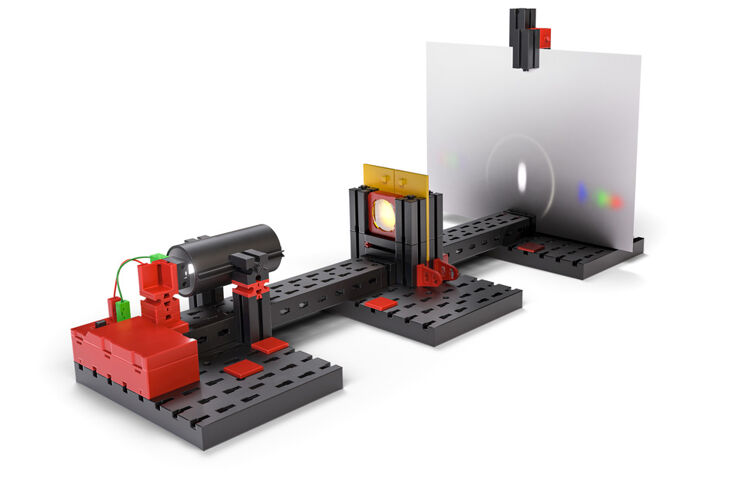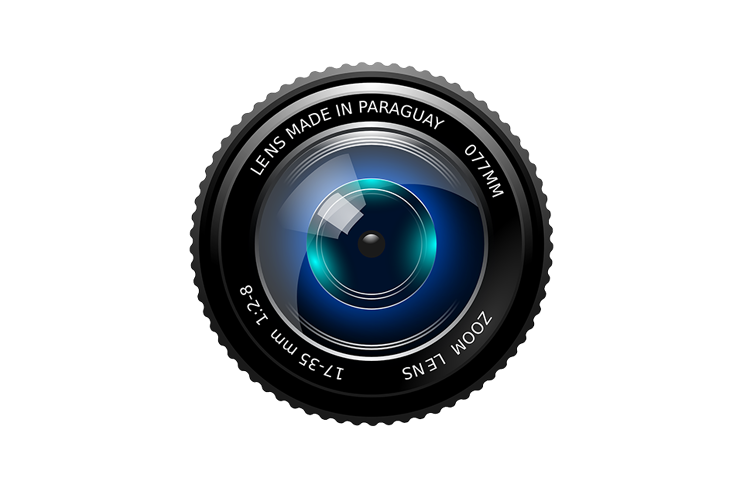
- Products
- Toys
- Schools
- Industry and Universities
- ft Design Studio
- Service
- fischerTiP
- Home
- Schools
- Learning material
- STEM Optics
Make the basics of optics comprehensible and understand them in the long term!
Developed especially to do justice to the demanding requirements of regular lessons, this set offers a comprehensive collection of 18 models, which help pupils to explore the basic principles of optics in a playful and interactive way. Starting with basic concepts such as the magnifying glass and the paths beams take through different lenses, the set leads learners to more complex subjects, such as telescopes, spectrums, microscopes or projectors. Each model has been designed with great care and can be set up quickly thanks to the unchanging lens holder in connection with the optical bench, guaranteeing a smooth workflow in hands-on lessons. This gives learners the opportunity to actively experiment, observe and explore. The didactic accompanying material supports the pupils’ journey of discovery and provides detailed instructions, explanations and tasks, which turn learning into an integrated experience.

Topics and competences
Further information
The experiments and models in the fischertechnik Optics building set convey a wide range of knowledge and skills in the field of optics in an integrated and hands-on way. Many subjects from the secondary school curriculum are covered: the straight-line propagation of light, the law of reflection, the function of converging and diffusing lenses, how images are produced, the way several lenses work together in optical instruments such as telescopes and microscopes, defective vision, spatial vision, the wave properties of light, the spectrum of the sun and other light sources, absorption and emission. At several points, historical and astronomical cross-references are also given, thus promoting interlinked learning.
The order of the 19 experiments follows the principle “from simple to complex”. The first models are only made up of a few parts and do not require any settings. This gives those new to fischertechnik the opportunity to familiarise themselves with the system. The requirements on construction precision and setting are then slowly increased in the following models.
At the same time, the order of the models also takes didactic aspects into account. The straight-line propagation of light is explored experimentally using the camera obscura first, for example, and then deepened several times in tasks on later models. Equally, the law of reflection is dealt with in a separate model and then applied repeatedly in subsequent models. The central concept of magnification is addressed for the first time with the magnifying glass and then explored in greater depth with the telescopes and microscopes. The Kepler telescope is dealt with before the historically earlier Galilean telescope because it is easier to understand (combination of real image and magnifying glass). The practical lens-handling skills gained with telescopes and the handheld microscope are preparation for the subsequent quantitative investigation of the imaging properties of converging and diffusing lenses on the optical bench. The final model is the spectroscope, which can be used to observe the Fraunhofer lines in the solar spectrum no matter the weather.
The lesson plans (building the model + processing the tasks) are usually designed for a double lesson. Some leave time for supplementary theory.
Content-related skills: describing the physical aspects of the visual process, explaining the function of models in physics, investigating the basic phenomena of light propagation in experiments and describing it with the aid of the light beam model, describing scatter and absorption in terms of phenomena, investigating shadow phenomena in experiments and describing them, explaining optical phenomena in space (moon phases, solar eclipse, lunar eclipse), describing reflection on level surfaces (law of reflection, mirror image), describing refraction, describing the images produced by an aperture (pinhole camera), describing the effect of optical lenses (converging lens, focal point, perceptive effects such as the reversal of images), describing simple experiments for breaking down white light and adding colours (prism)
Process-related skills: problem-solving/ being creative, observing phenomena and experiments precisely and describing observations, setting up hypotheses for physical issues, carrying out and evaluating experiments and recording measured values for these
Mathematical skills: logical and strategic thinking; estimating, measuring, comparing Personal and social skills: finding a solution together in a team, hand-eye coordination (focussing), observing, transfer model <--> drawing
Language communication skills: development of specialist terms, discussing, evaluating, wording correlations
Introduction to optics
Optics – when people hear this word they tend to think of glasses, cameras, telescopes and microscopes, in other words of optical articles of daily use and optical instruments.
Glasses help their wearers to see better. Cameras allow images to be taken and saved. Telescopes allow objects that are a long distance away to be seen as though they were much closer. Microscopes enlarge small objects and allow us to take a detailed look at the otherwise hidden microcosm.
In other words, optics is about what and how we see something with our eyes and use this understanding to be able to see more, better, differently, in more detail or at greater distances.
What we perceive with our eyes is light. For this reason, the examination of light and its properties is of central importance. In the past, the knowledge gained in this field has by no means only had applications for vision. Today, we control TV sets or stereo music centres with infrared remote controls, for example, lasers are used for operations, and light conveys information at top speed through fibre optic cables. All these applications are in the field of optics.

The history of optics is very diverse. At the beginning was the observation and explanation of phenomena which have to do with the straight-line propagation of light: reflection, refraction and the creation of shadows. These phenomena were investigated in depth in antiquity.
Also known in antiquity were crystal lenses, which were used as burning glasses for making fire, as reading aids or to correct short-sightedness.
Glasses were invented in the 13th century, where exactly and by whom is not known.
With the invention of the telescope at the beginning of the 17th century, combinations of lenses in an optical instrument were used for the first time.
Galileo Galilei (1564-1642) gazed into the night sky with his self-built telescopes from 1609 onwards. He discovered craters on the moon, spots on the sun, four moons orbiting around Jupiter, the phases of Venus and broke the Milky Way up into countless small stars. These discoveries were so spectacular that, on the one hand, they changed both the scientific world view and human self-perception permanently. On the other hand, they were an enormous driver for the development of better lenses and, more generally, further optical instruments.
Johannes Kepler (1571-1630) explained the optical effect of the lenses in a telescope for the first time, and improved it for astronomical purposes by using ocular converging lenses instead of diffusing lenses.
Christiaan Huygens (1629-1695) developed a comprehensive theory about light wave properties around 1650; these only became generally accepted following the double-slit experiment by Thomas Young (1773-1829) in 1802. However, Huygens had already made practical use of his theory and thus reduced the imaging errors of his lenses.
Isaac Newton (1642-1726) fanned white light out into all the different colours with his prism. He was of the opinion that light was made up of lots of small particles which moved in a straight line.
In 1663, Robert Hooke (1635-1702) from the Royal Society in London presented numerous drawings of objects that he had observed with his reflected light microscope, including compound eyes of insects, mould and fossilised wood. The observations were printed in his famous book Micrographia, which is still fascinating to look at today. Antoni van Leueuvenhoek (1632-1723) discovered bacteria and other micro-organisms as well as blood cells in the next few decades. His microscopes only contained one single extremely curved lens.

During his observations of the four Jupiter moons discovered by Galilei by telescope from 1668 onwards, Ole Rømer (1644-1710) found delays in the eclipses and transits that could only be convincingly explained by a finite speed of light. In 1676, Christian Huygens used Rømer’s observations to calculate a value of 212,000 km/s for the speed of light. Since antiquity, it had not been clear whether light travels at a finite or infinite speed.
Friedrich Wilhelm Herschel (1738-1822) discovered infrared radiation during his experiments with prisms in the year 1800. This meant that there were other kinds of invisible beams alongside visible light. It was not until the electromagnetic field equations by James Clerk Maxwell (1831-1879) and the generation of electromagnetic waves in 1886 by Heinrich Hertz (1857-1894) that it was shown that both light and infrared radiation are nothing more than high-frequency electromagnetic radiation
Josef von Frauenhofer (1787-1826) built prisms that far surpassed the quality of all the ones built previously. His spectacular discovery of the dark lines in the sunlight spectrum marks the beginning of astrophysics. Spectroscopy is one of the most important physical methods today. In addition to its many applications in astronomy, atomic and nuclear physics, it is also used, for example, in the development of new materials, in medicine and in forensics.
In 1900, Max Planck (1858-1947) discovered the Planck’s radiation law, which is regarded as the start of quantum physics. Albert Einstein (1879-1955) explained Planck’s observation and the photo effect by the introduction of light particles, or so-called photons. This meant light had both particle and wave properties. Einstein described the stimulated emission of photons as far back as 1916. However, it was a few more years before the laser was invented in 1960.
